(Does it lead to a Scientification of Philosophy?)
Homepage section III
| God The Numerologist 1 | God The Numerologist 2 | God The Numerologist 3 |
Progressive Thinkers as of 1/4/2023
In my pursuit of what I am calling a "Science of Philosophy" involving what may be described as a "Standard Cognitive Model" the recognition of repeating patterns has detailed some of the following repetitions in an effort to distinguish fact from fiction, the objective from subjective, and nature from nurture:
- Numbers can be used as symbols referencing ideas which can be reduced to enumeration as a means of itemization.
- Numbers need not be indoctrinated nor inculcated with attendant personalizations akin to some enculturation for ulterior motives involving the exploitation of others.
- Small numbers are most frequently occurring in all subjects, even though a particular author may not specifically engage in the use thereof.
- Some (small) numbers appear more frequently than other (small) numbers.
- The assortment of small numbers being repeated such the presence of a "Conservation of Number".
- There are large number repetitions but they appear to be contextually applied and not found in multiple subjects.
- Examples of patterns are more easily seen when in close proximity, though in some cases some are recognized as a group occurring over a short period of time.
- Long periods of time being used in the construction of an example are often referred to as coincidence or meaningless by many observers.
- Examples may appear as ensembles of a given pattern being sought, but the symbols or language being used appears to be provisionally unrelated.
- Whereas models of ideology have already been established, old ideas can be revisioned (revised) while new ones established to provide a better leverage of identification and analysis.
Here are some basic models being used in different contexts, some being afforded with lesser and others with greater flexibility of application:
|
While the foregoing have been used to establish the fledgling essence of a Scientific Philosophy, they often fall victim to being altered to portray the contextual expressions of the subject they are being applied to. They don't collectively stand their ground, though their appearance in the above list may suggest otherwise to some readers. They become mangled, disjointed and otherwise subjected to an irreverent form of being named by those who are claiming ownership of in one subject or another, much as an indentured servant, slave or infant is named. Yes, far too many want to take advantage of Philosophies budding innocence to begin standing on its own two feet after crawling along for so many centuries in and out of the different doorways that multiple subjects have held their door open to because philosophy can provide the vibrancy of a new life to musty shelves and dimly lit corridors and crevices of so many antiquated ideological corners the human mind finds itself huddled in. Yet, if not the foregoing is akin to a child's first words, what then is the useful speech pattern by which to express its own formative personality, its own physical stature, and exert what can only be described as the leader it was meant to be... arriving as it were from the ranks of the most humblest beginnings?
Indeed, let its first three words be: "1- 2- Many" as a precursor of a greater language yet to come.
Every single idea, every belief, every notion, every nuanced supposition, reverent or irreverent (with or with accompanying behavior) that is being used for a moment, for awhile, for a lifetime... is a whole, partial, or fragment of a philosophy, whether you label it a philosophy or not, and whether you agree with an idea or not. Even a grocery list can be viewed as part of a person's characteristic day -to- day philosophy that may not reach some conclusion until one goes shopping, and is subject to revision depending on a particular item's availability or price. So are chores, whether you commit them to a listed serialization (as you do a grocery or "things-to-do") list or not. Every routine, every habit, every digression can be viewed as a philosophy, whether or not the word is a customary word being used in your social vernacular or not. Whether you think it expresses a person's haughtiness or level of education or even some pretence to intellectual sophistication, the fact remains your ideas, with words or numbers or some other symbols and sounds, can all be labeled a philosophy, whether a person reserves the word for some special intellectual attribute or not.
My many decades of research into the "threes" phenomena (ideas and activities occurring in groups -of- three), has led me to the point of deducing a few recurrences with respect to patterns which repeat themselves in certain contexts. While I have an interest in the "three" (such as we find in Fairy tales, Mythology, Religion, Science, writing, etc...); I also pay witness to its absence and the presence of some other pattern, be it a number or otherwise. And though there are larger numbers than the first nine or so (0,1,2,3,4,5,6,7,8,9...), such as 12 for the twelve months of the year and 365 for the days in a year, or even the concept of infinity, I do not find large numbers being repeated in multiple subjects. They are contextually isolated events. Apparently Nature likes the Number three, but this may on occasion occur in an ensemble form such as the 2 strands of DNA along with a 3 (triplet) code and 4 bases (which we can view as 3 to 1 organization). Hence, we see a 2- 3- 4 pattern-of-three.
I have also come across the recurring three-patterned ensemble of "1- 2- Many" which has been extremely useful in deciphering underlying patterns found in Religion and philosophy, but I have begun extending it into other realms of exploration as well. When applying the ensemble as a tool of dissection in philosophy, it occurred to me that philosophy is not an established science in its own right. It is used as a domestic helper, if not an indentured servant to all other subjects who use their respective symbols and language for whatever purposes a given researcher thinks is best. In many cases, philosophy is treated like a slave that has never enjoyed a true freedom. While there are those who may be quick to argue that it is philosophy which is queen to all subjects, and they would likewise be quick to flip-flop the heading of this page into the common theme "Philosophy of Science", the two are appreciably different. While the "Philosophication of Science" has already been put to use for several centuries, there is no representative idea involving the "Scientification of Philosophy". Philosophy is not understood from this vantage point. It is a strange vernacular to speak in terms of a "Scientific Philosophy" when so many interpret philosophy in relative "generically specific" terms applied to one context or another, but never the whole enterprise of philosophizing. Yet, I have not interest at the moment in quibbling over semantics. I want to introduce you to a person given the name Laozi. He said one thing that I find of especial interest for the present context:
Laozi:
- Dao produces one.
- One produces two.
- Two produces three.
- Three produces the ten thousand things.
(In classical Chinese, the "ten thousand things" means "everything." Commentators have long disagreed over what the "one, two, and three" refers to, usually plugging in their favorite cosmological, cosmogonic, or metaphysical model.) Laozi further writes: Something amorphous & consummate existed before Heaven & Earth. Solitude! Vast! Standing alone, unaltering. Going everywhere, yet unthreatened. It can be considered the Mother of the World. I don't know its name, so I designate it "Dao." Compelled to consider it, name it "Great." (Dao is considered indistinct & undefinable.
I am not talking about "Dao" with respect to emphasizing it as the point I want to bring up. I had recorded the above commentary several decades ago and placed it as one of the "threes" examples on an old poster I had printed up: BTR poster column 5. On December 31st (2022) the following image came to mind, and I realized it to be an updated version of Laozi's idea, suggesting he was on a path to develop a "Scientific Philosophy" as it was possible to do so within the limits of his era and frame of mind where such a concept may not have even existed:
|
Again, I am not emphasizing "Dao" or any Eastern Philosophy or Religion, though all of them apparently have had thinkers who brushed the against what can be described as a "forbidden" territory of creating a Science of Philosophy, because this would bring into question their adopted belief systems. As far as I'm concerned there is no Western Religion or Eastern Philosophy which can rightly be interpreted as THE way, not to mention I'm not particularly religions, though I did have someone call me a life savior once for changing their tire and another person call me a saint and scholar because I leant them some money.
Dao: Chinese "way," "road," "path," "course," "speech," or "method" (Wade-Giles romanization: Tao).
The word for this concept, dao, indicates a "way" in the sense of a road or a path. Owing to the contextual nature of Chinese languages and depending upon its use in a sentence, dao can function as a noun or a verb. It may indicate the road upon which one travels, the act of wayfaring or traveling down a road, or even the act of way-making by leading someone down or constructing a road. It may also refer to speech, especially in philosophical or moral education.
In the latter sense, dao may refer to a philosophical tradition: a thinker's disciples maintain his dao, which they subsequently transmit (in both speech and writing) to their own students, and so forth. For example, Confucius (551–479 BCE) believed that he was restoring the dao of the ancient sage-kings. Mencius (flourished 4th century BCE) was subsequently considered the orthodox interpreter of Confucius's dao. The great 12th-century-CE thinker Zhu Xi believed that he was resurrecting daotong, the transmission of the Confucian Way, which he claimed had been lost in the previous few centuries. Likewise, the tradition that subsequently became known as Daoism (daojia) traced itself back to thinkers such as Laozi (assumed, if he existed, to have been a contemporary of Confucius) and the 4th-century-BCE sage Zhuang Zhou, or Zhuangzi ("Master Zhuang"). Those thinkers and their disciples promoted the Cosmic Dao, which they claimed was a greater guide to life and good government than any human teaching. ("dao." Encyclopædia Britannica, 2013.)
I placed the above on Page 6 of the Language Narrative series. I do not know where it came from. It just suddenly appeared and I jotted it down. It clearly is an extension, is a 2500 year update to Laozi's idea, and removes it from a specificity for the idea of "Dao" and places itself in the position of being a "stand alone" philosophy. Laozi was on the trail of an idea that could later be used as a code for taking computers into the next generation beyond the binary, as well as understand the recurring triplet code of DNA and why the "three" is such a recurring theme in particle physics. When Chinese thinkers get a hold of this, they will be able to leap ahead of the conventions of thought being used by Western Philosophy. The recurring triplet code in DNA and the recurring "threes" theme in particle physics, are expressions of what I refer to as a "Conservation of Number" that is caused an incremental deterioration impacting life forms to adopt a form of adaptation in concert with a reduction in resources, which influences the construction of ideological rationalizations, clearly being represented by the currency of present day religious and philosophical orientations. However, let us not overlook that the recurring themes of repetition may be an exercise representing some unacknowledged "survival mode" taking place. I say survival mode, particularly in the case of DNA's triplet code because you would think after several billion years it would have advanced... would have evolved to some larger patterned number, unless it is being forced (let us say reinforced) to submit itself to a currency of repetition conducive to conditions which are repeating themselves but give us not guarantee that they won't or couldn't be abruptly altered. In other words, why isn't DNA evolving if it too is part of Evolution? Why this... (if I may take a word from psychology)... why this model of sanity when mutation suggests that insanity is an attribute as well, at least in a primitive interpretation thereof? (In other words, is mutation an expression of insanity, or is it a frantic means of seeking a greater sanity than that being practiced by the current social environment of cellular activity?)
Western Philosophy will not survive the onslaught of Eastern thinkers using a three-patterned "1- 2- Many" tool of investigation and dissection. They will quickly grasp the cyclicity and not be tethered by the Western traditions of mechanistic thinking which creates a complacency in its presumed position of ascendancy backed by an arrogant Mathematics that can not recognize it is a mirror-imaged Westernized version of the old Yin/yang tradition tied to a complementary dualism. Like the fluidic expression of calligraphy, Eastern philosophy is enabled to more easily adopt more complex variations of basic themes. Laozi's idea is a simplified version of that shown up, representing a tradition of cognitive orientation that is foreign to Western minds. Metaphorically, while the Western mind is busy collecting fireflies in a jar, the Eastern mind adopts the behavior into a philosophy summed up by the notion that all of us are at one time or another engaged in chasing fireflies. There is a distinctly important difference in the two forms of conceptualization. Eastern thinkers will be more adept to quickly assimilate the updated revision of Laozi's idea and place it into multiple contexts. In effect, they will beat Western thinkers in creating the conditions for a "Scientification of Philosophy".
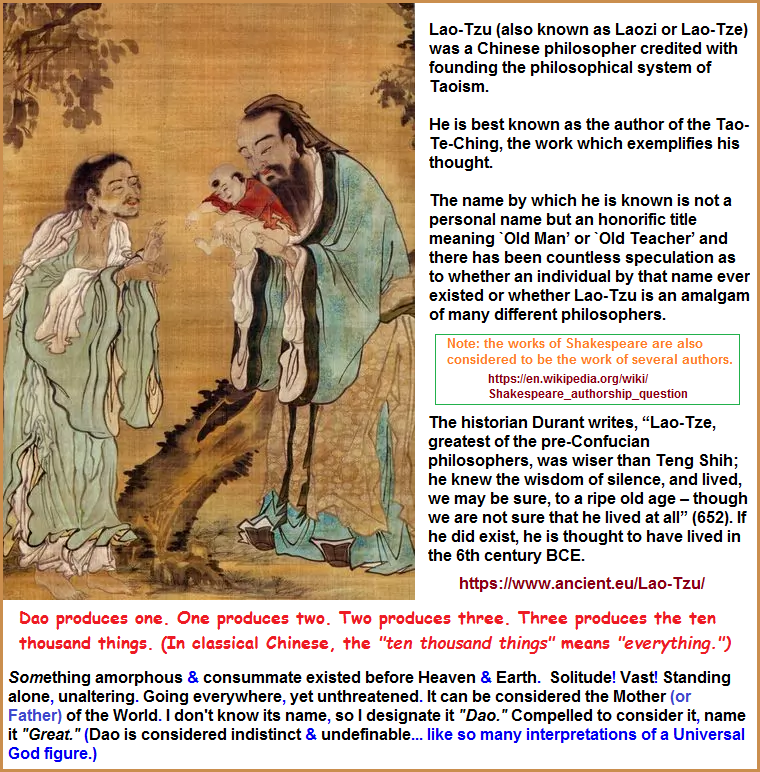
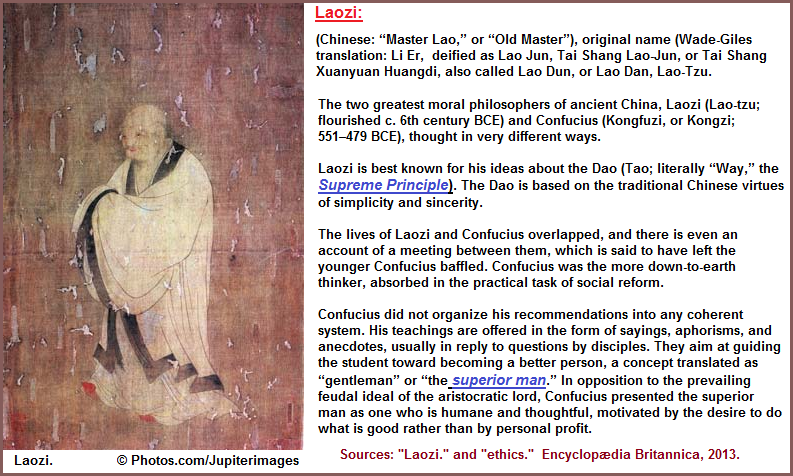
Different words and symbols are used when a person describes their version of a "1- 2- Many" model of thinking. Let me provide one such model in an image previously used in describing a standard cognitive model which details some synonyms that might be used in different contexts:
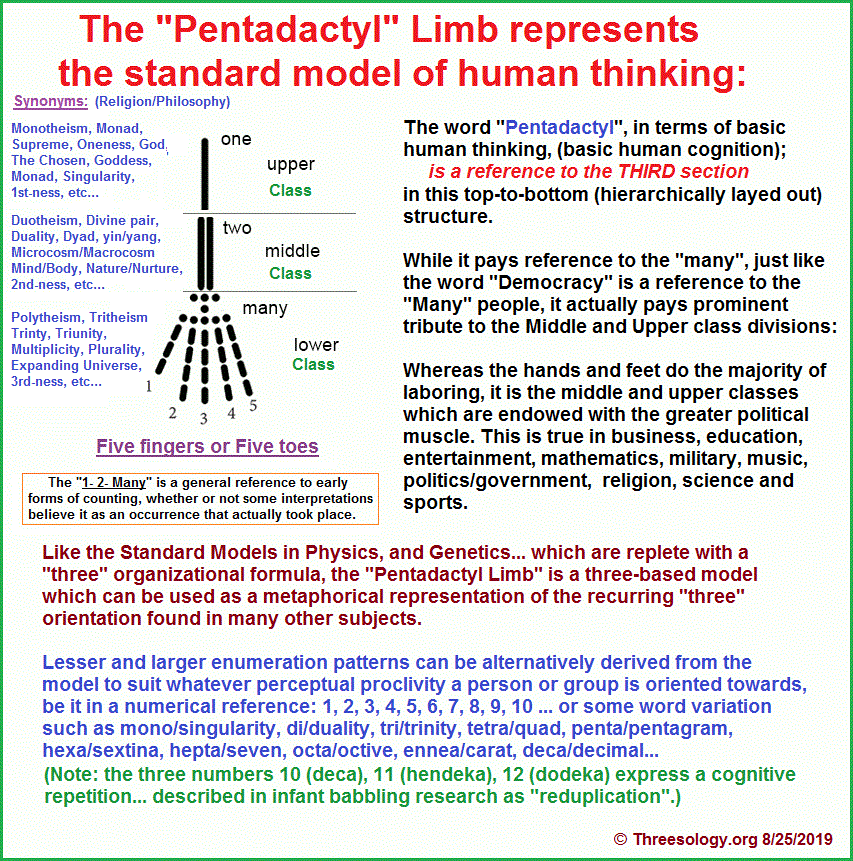
What is not explicitly shown is the evident cyclicity of the pattern being used by humanity and Nature. Apparently, the "many" position is reached and some foreknowledge of a coming change, a "New Age" or New Consciousness in the development is a characteristically recurring theme in the topic of "millennialism", or thousand year period. This coincides with the change in thought processing involving place value notation in arithmetic which is accomplished by using a comma between the hundredths and thousandths positions. After the value of 999, we use a comma to make a change to thousands. The place value system of notation is a symbolic way of expressing an underlying cognitive theme that philosophy has labeled as millennialism, but no one has made the connection between the two as being representative of an underlying cognitive activity involving a transitional state or stage of development that can occur backwards, downwards, sideways, diagonally and not upwards or forwards.
Let me provide an example of how using the "1- 2- Many" model an help elucidate a larger pattern of overall activity taking place with humanity. While it is understood that past cultures engaged in Nature worship with or without some fertility cult taking the place of some later organized religious orientation, the Nature or animal worship populations held a multiplicity of perceptions as an expression of what later became termed to be spirits or gods. In other words, there were a multiplicity or would-be pantheon of items that were used as points of reverence, good or bad/evil. As the mind/brain of humanity began to evolve into what may be described as an "enlightened" or advanced consciousness, we can pay witness to the development of "Oneness" in the idea of there being only one god. Hence, the human mind was expressing a trend from the Many (polytheism) to the One (Monotheism). And yet, there arose Three great Monotheisms noted as Christianity, Islam and Judaism, all of which arose in desert climates and may thus suggest that if the developmental trend of humanity occurred in a jungle, sea fairing or wooded environment, the theologies may never have developed, at least not in the way they are. However, the point is that the human mind went from a "Many" theme to a "One" theme. The trouble is, that if we take into account the Many types of Religions and Philosophies in the world, the time is ripe for a new "oneness" of conceptualization to arise.
In several accounts of history we find that the inception of anew belief arose by way of one or more founders who did not like or accept the prevailing many different views being espoused in their era. In other words, they took in Many different views and created a single view, that may or may not have turned into a major theme, such as the case in which Joseph Smith came to developed the Latter Day saints notion. Yet, he is but one of several whose singular response came as a result of amalgamating many views it a particular era. With the point being is that there is a cyclicity of the "One/Many" theme take in place such as is also described by the "E Pluribus Unum" (Out of Many, One) slogan on the U.S. Presidential seal, suggesting that the U.S. government is tied to the very same kind of One/Many theme which gave rise to Judaism. Hence, the U.S. government appears to have more in common with Judaism then it does with Christianity, which is extremely problematic for some.
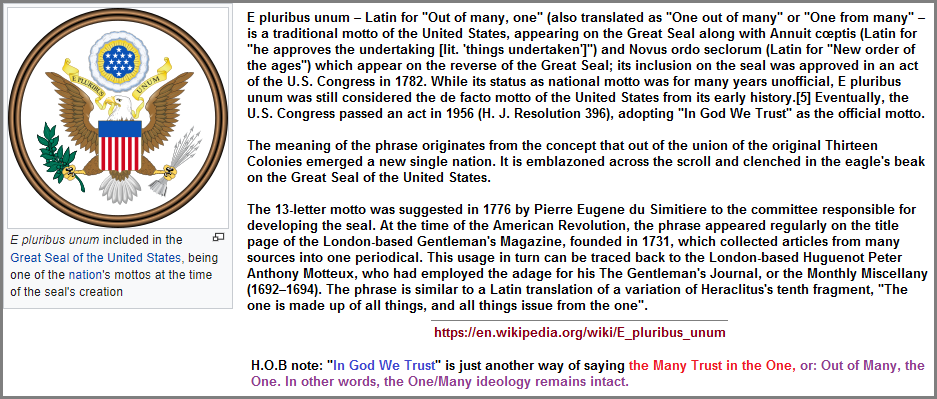
Another example is the development of the U.S. Army which combined several independent groups into a singular unit. Hence, a many-into-one representation, that often creates singular independently acting groups that may or may not be given an especial public designation, though some secret labeling typically is used as a means of referencing those in the group.
The American military system developed from a combination of the professional, national Continental Army, the state militias and volunteer regiments of the American Revolutionary War, and the similar post-Revolutionary War American military units under the Militia Act of 1792. These provided a basis for the United States Army's organization, with only minor changes, until the creation of the modern National Guard in 1903. The Militia Act provided for the use of volunteers who could be used anywhere in time of war, in addition to the State militias who were restricted to local use within their States for short periods of time. Even today's professional United States Army, which is augmented by the Army Reserve and Army National Guard, has a similar system of organization: a permanent, professional core, and additional units which can be mobilized in emergencies or times of war. (Regular Army (United States))
Let me end this page with a digression involving a comment about the idea that humans are enabled to reach what has been described as a "higher consciousness", typically by way of doing or saying something in a repetitive way:
The frequent usage of three-lettered or 3-sounds or 3-part utterances used for meditation can be seen as hearkening-back to the babbling stage of infancy out of which the infant acquires what can be described as an "ascendancy" to a higher state of consciousness/being called a walking, talking, self-toileting child. Whereas many a parent speaks of an infant's 1st word and then the child's 1st step, it is not typical to think of consciousness as a multi-generational event that can be accurately measured by some definitive behavior to be checked off of a "developmental milestone" list of accomplishments.
One must wonder if this period in infancy leaves an indelible mark on the human psyche whereby adults in different contexts and with different languages or symbology, engage in some representative type of "babbling" (repetition) of vocalization (speech or other forms of expression) which in several cases propels them to a higher state of being such as in the case of achieving some social status of recognition out of which they reach some socially constructed (makeshift, make-do, alternative/alternate) "heaven on earth" like that which living in a Mansion or working in Congress, or teaching at a University, or getting a job or getting married, or having a baby, getting a divorce, etc., might well be felt has a higher ascendancy of one's former self-affirming idealization. (The "self" of a child is frequently established by recognizing one's name or one's gender, race, religion, etc...)
In accounting for the wide-spread usage of Mediative chants, songs, and other behavior, some of which use a distinct pattern-of-three such as in the case of "Om" (A-U-M) let us make note of the following:
The fact that infants do engage in a "developmental mile-stone stage" of repetitive (utterance) babbling that is followed by an ascendancy into a higher consciousness by way of a natural maturational growth process, may in fact leave an indelible mark on the developing (and impressionable/vulnerable) human mind which glimpses its origination as one in which it is surrounded by a "cloud or shroud" and retains the image as an 'echo', as a shadow, as an indistinct hint, as a presence, as a phenomena, as clue which is highly suggestive to a curious mind and that acts like a reverberation of (consistent or intermittent) concentric (uni-centric? bi-centric? tri-centric?) waves (undulations) which is sought after in adult life in multiple formulas; one of which is the tendency of some to advance a view involving the notion of "vibrations" or "subtle energies" or simply described as being "something there"... at the territorial tip of one's consciousness domain which they are compelled to seek out.
In addition, this transitional activity of moving into a different "plane" of consciousness after infancy was preceded by the long-held view by some that birth itself was a process of acquiring a higher consciousness by way of a tunnel with a light at the end of it; suggestive of the birth canal and the presumed birth trauma where the body must quickly adapt itself to life outside the womb; which one can easily view as an analogy to the concept of acquiring a higher consciousness from a fluid to a gaseous (oxygen) state of existence which used multiple kinds of non-biological substances for the developmental processes. Hence, these two episodes constitute a "1st- and 2nd- staging event" and the search for a 3rd in waking life makes up the trio that apparently pervades so many inclinations, aspirations and sought-for accomplishments.
Hence, the three:
- Singular (but repetitive) vocalization (wailing/breath-gasping) event of the birthing cry.
- Dual repetitive (consonant/vowel) utterances of infant babbling.
- Triple-patterned repetitive vocalizations used as meditative chants.... seeking transcendence.
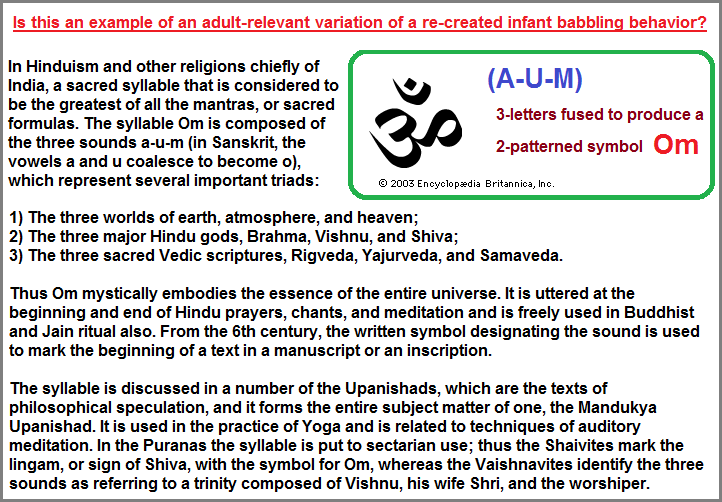
Date of Origination: Wednesday, 4th January 2023... 4:36 AM
Date of Initial posting: Wednesday, 4th January 2023... 4:41 PM
Updated posting: Monday, 3rd April 2023... 10:12 AM
